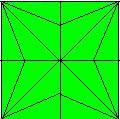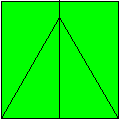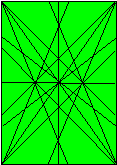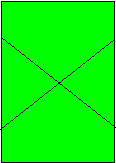An angular system is a system of
related angles which are used to create an
origami design.
A folding geometry is a method of
creating an angular system.
Folding geometries are of three
quite distinct kinds, natural, embedded and
non-located. In the first two kinds of folding
geometry the folds and/or creases are positioned
by the use of location points. In the third kind
the position of the folds and/or creases are
positioned by eye (though their positions may
subsequently be refined by an iterative process).
Two or more of these distinct types
of folding geometry may be combined within a
single design.
Primary and Secondary
Folding Geometries
The primary folding geometry of a
paper-shape is the folding geometry obtained by
using just the primary reference points (the
original edges and corners of the paper-shape) to
determine where the creases will form.
In order to explain these concepts
clearly we will first consider the simple case of
the square.
The primary folding geometry of the
square consists of two creases obtained by
folding opposite edges onto each other and two
creases obtained by folding opposite corners onto
each other. The first set divide the square into
four smaller squares. The second set bisect these
smaller squares at 45 degrees. The resulting
crease pattern is familiar as the crease pattern
of the waterbomb base and preliminary fold.

The primary folding geometry creates
secondary reference points. In the case of the
square these additional reference points are the
four internal creases and the five points where
the internal creases intersect each other and the
edges of the square. These secondary reference
points can be used to locate further creases,
thus producing a secondary folding geometry.
For instance, the picture below
shows the crease pattern of the bird base which
can be obtained as a secondary folding geometry
of the square.

We can call this angular system the
90/45 degree system or simply standard folding
geometry. The vast majority of origami designs
folded from squares use this angular system.
Embedded Secondary Folding
Geometries
An embedded folding geometry is a
folding geometry obtained using secondary
location points which would more naturally be
obtained as the primary folding geometry of a
different paper shape.
The most common example of the
creation of an embedded secondary folding
geometry is the way in which an angle of 60
degrees can be produced by folding two adjacent
corners of a rectangle onto a crease obtained by
folding the rectangle in half from edge to edge.

We can call this angular system the
60/30 degree system. It is natural to the bronze
rectangle (and of course to the hexagon and
equilateral triangle) but needs to be embedded in
all other paper shapes.
The 60 degree system is the most
commonly used embedded folding geometry.
Other Rectangles
The natural folding geometry of
rectangles other than the square is more complex
(and thus offers more interesting opportunities
to the origami designer). The drawings below
shows the grid of creases that can be obtained
using the corners and edges of a typical oblong
as location points.

The usefulness of the natural
folding geometry of a rectangle is largely
determined by the angle at which the creases
formed by folding opposite corners together cross
(or the angle at which the diagonals cross -
which is always the same).

Other Natural Angular
Systems
There are clearly as many natural
angular systems as there are rectangles to derive
them from. However the most commonly used angular
systems met in modular origami design are:
The 90/45 degree system, or
standard folding geometry, natural to any
rectangle.
The 120/60/30 degree system
natural to the bronze rectangle, hexagon
and equilateral triangle but also easily
embedded in other rectangles.
The 109.28/70.32/54.84/35.36
degree system natural to the silver
rectangle but also easily embedded in
squares and other rectangles.
The 108/72/36 degree system
natural to the twin platinum rectangles
but most commonly found in modular
origami in its approximated form as mock
platinum folding geometry. Mock platinum
folding geometry is derived from 1:3
rectangles but also easily embedded in
squares and other rectangles.
The 116.34/63.26 degree
system natural to the golden rectangle
but also easily embedded in other
rectangles.
All angular systems natural to one
particular rectangle can be embedded in any other
rectangle (indeed in any other paper shape) by
means of a careful choice of location points.
Non-located Folding Geometry
A non-located folding geometry is
one where the folding geometry is not accurately
located and is initially established by eye
alone, by means of what is sometimes known as a
'right about there' fold.
This type of folding geometry is
most commonly met in the method of dividing an
edge or a crease into three (or five) roughly
equal parts by means of a first guesstimate
refined by an iterative process.
There are however a number of models
where the whole folding geometry of the design
depends on a 'right about there' non-located
fold.
|